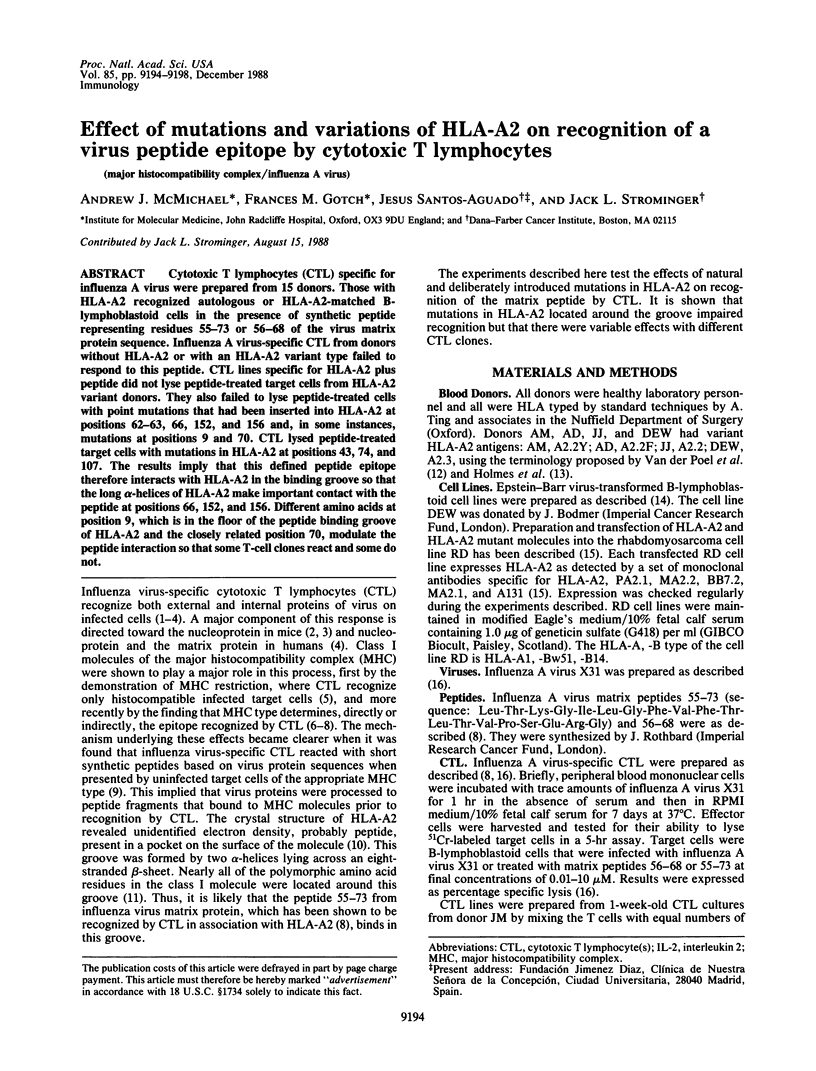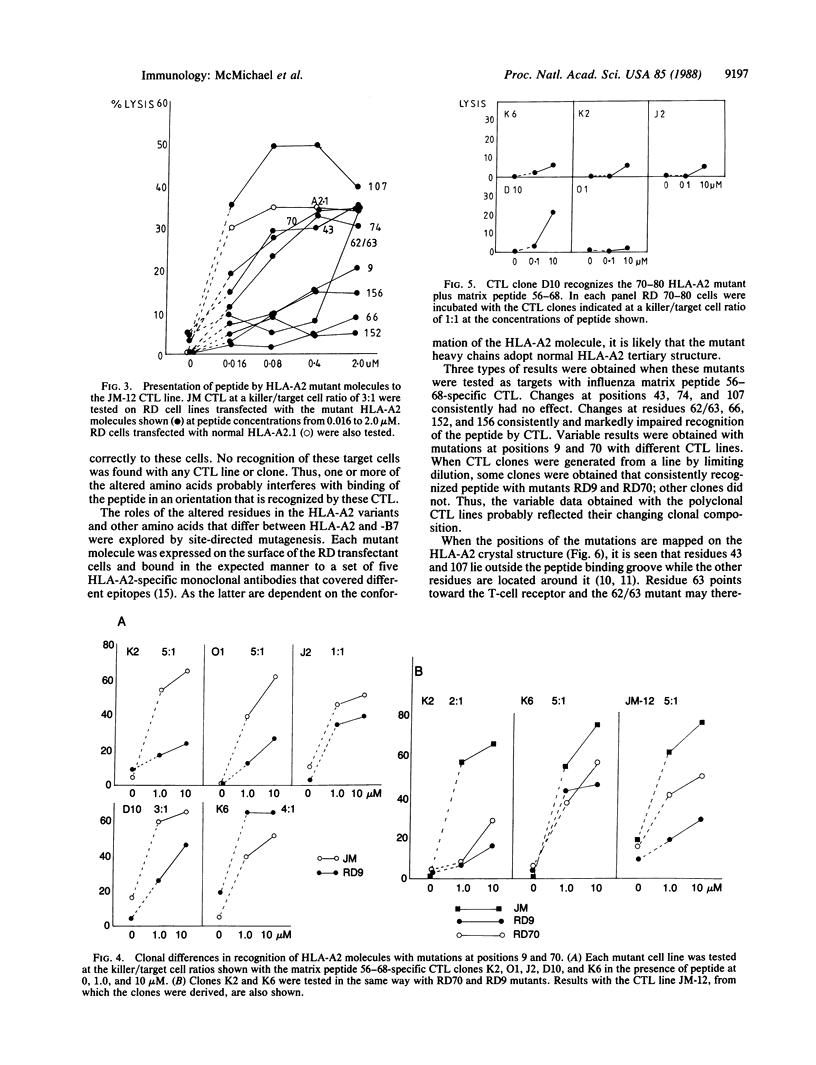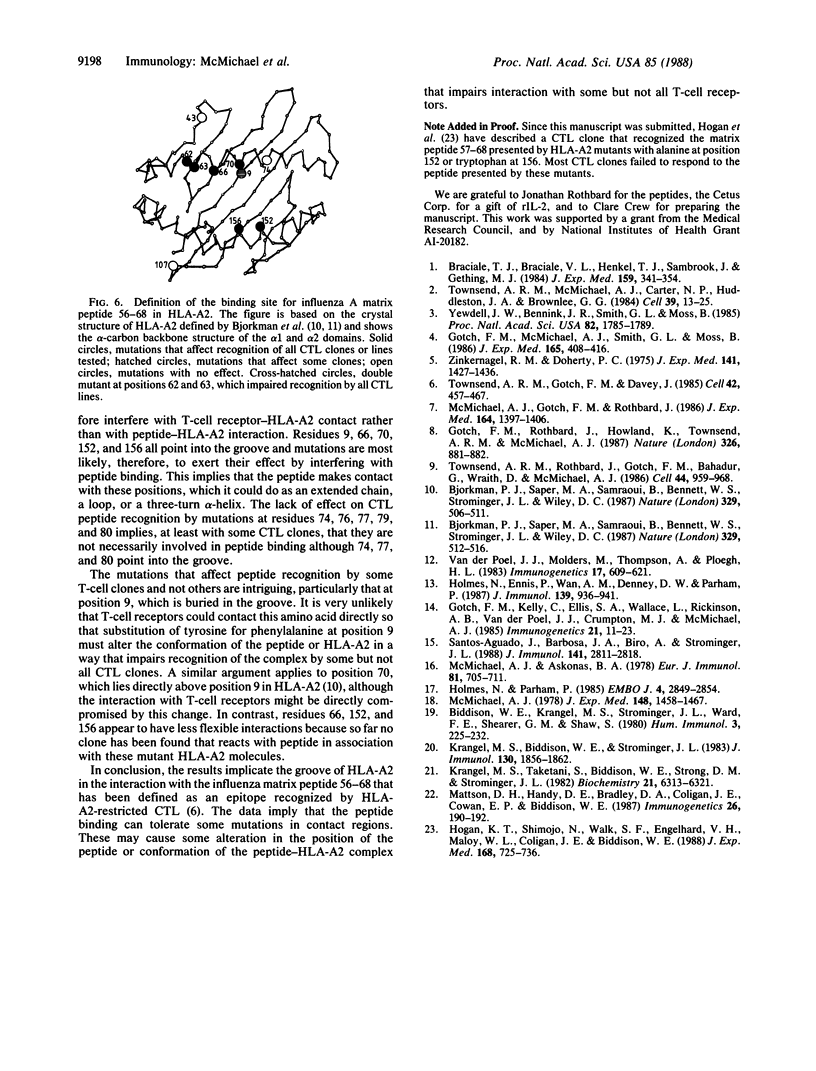Abstract
Cytotoxic T lymphocytes (CTL) specific for influenza A virus were prepared from 15 donors. Those with HLA-A2 recognized autologous or HLA-A2-matched B-lymphoblastoid cells in the presence of synthetic peptide representing residues 55-73 or 56-68 of the virus matrix protein sequence. Influenza A virus-specific CTL from donors without HLA-A2 or with an HLA-A2 variant type failed to respond to this peptide. CTL lines specific for HLA-A2 plus peptide did not lyse peptide-treated target cells from HLA-A2 variant donors. They also failed to lyse peptide-treated cells with point mutations that had been inserted into HLA-A2 at positions 62-63, 66, 152, and 156 and, in some instances, mutations at positions 9 and 70. CTL lysed peptide-treated target cells with mutations in HLA-A2 at positions 43, 74, and 107. The results imply that this defined peptide epitope therefore interacts with HLA-A2 in the binding groove so that the long alpha-helices of HLA-A2 make important contact with the peptide at positions 66, 152, and 156. Different amino acids at position 9, which is in the floor of the peptide binding groove of HLA-A2 and the closely related position 70, modulate the peptide interaction so that some T-cell clones react and some do not.
Full text
PDF




Selected References
These references are in PubMed. This may not be the complete list of references from this article.
- Biddison W. E., Krangel M. S., Strominger J. L., Ward F. E., Shearer G. M., Shaw S. Virus-immune cytotoxic T cells recognize structural differences between serologically indistinguishable HLA-A2 molecules. Hum Immunol. 1980 Oct;1(3):225–232. doi: 10.1016/0198-8859(80)90017-8. [DOI] [PubMed] [Google Scholar]
- Bjorkman P. J., Saper M. A., Samraoui B., Bennett W. S., Strominger J. L., Wiley D. C. Structure of the human class I histocompatibility antigen, HLA-A2. Nature. 1987 Oct 8;329(6139):506–512. doi: 10.1038/329506a0. [DOI] [PubMed] [Google Scholar]
- Braciale T. J., Braciale V. L., Henkel T. J., Sambrook J., Gething M. J. Cytotoxic T lymphocyte recognition of the influenza hemagglutinin gene product expressed by DNA-mediated gene transfer. J Exp Med. 1984 Feb 1;159(2):341–354. doi: 10.1084/jem.159.2.341. [DOI] [PMC free article] [PubMed] [Google Scholar]
- Gotch F. M., Kelly C., Ellis S. A., Wallace L., Rickinson A. B., van der Poel J., Crumpton M. J., McMichael A. J. Characterization of the HLA-A2.2 subtype: T cell evidence for further heterogeneity. Immunogenetics. 1985;21(1):11–23. doi: 10.1007/BF00372237. [DOI] [PubMed] [Google Scholar]
- Gotch F., McMichael A., Smith G., Moss B. Identification of viral molecules recognized by influenza-specific human cytotoxic T lymphocytes. J Exp Med. 1987 Feb 1;165(2):408–416. doi: 10.1084/jem.165.2.408. [DOI] [PMC free article] [PubMed] [Google Scholar]
- Gotch F., Rothbard J., Howland K., Townsend A., McMichael A. Cytotoxic T lymphocytes recognize a fragment of influenza virus matrix protein in association with HLA-A2. 1987 Apr 30-May 6Nature. 326(6116):881–882. doi: 10.1038/326881a0. [DOI] [PubMed] [Google Scholar]
- Hogan K. T., Shimojo N., Walk S. F., Engelhard V. H., Maloy W. L., Coligan J. E., Biddison W. E. Mutations in the alpha 2 helix of HLA-A2 affect presentation but do not inhibit binding of influenza virus matrix peptide. J Exp Med. 1988 Aug 1;168(2):725–736. doi: 10.1084/jem.168.2.725. [DOI] [PMC free article] [PubMed] [Google Scholar]
- Holmes N., Ennis P., Wan A. M., Denney D. W., Parham P. Multiple genetic mechanisms have contributed to the generation of the HLA-A2/A28 family of class I MHC molecules. J Immunol. 1987 Aug 1;139(3):936–941. [PubMed] [Google Scholar]
- Holmes N., Parham P. Exon shuffling in vivo can generate novel HLA class I molecules. EMBO J. 1985 Nov;4(11):2849–2854. doi: 10.1002/j.1460-2075.1985.tb04013.x. [DOI] [PMC free article] [PubMed] [Google Scholar]
- Krangel M. S., Biddison W. E., Strominger J. L. Comparative structural analysis of HLA-A2 antigens distinguishable by cytotoxic T lymphocytes. II. Variant DK1: evidence for a discrete CTL recognition region. J Immunol. 1983 Apr;130(4):1856–1862. [PubMed] [Google Scholar]
- Krangel M. S., Taketani S., Biddison W. E., Strong D. M., Strominger J. L. Comparative structural analysis of HLA-A2 antigens distinguishable by cytotoxic T lymphocytes: variants M7 and DR1. Biochemistry. 1982 Nov 23;21(24):6313–6321. doi: 10.1021/bi00267a042. [DOI] [PubMed] [Google Scholar]
- Mattson D. H., Handy D. E., Bradley D. A., Coligan J. E., Cowan E. P., Biddison W. E. DNA sequences of the genes that encode the CTL-defined HLA-A2 variants M7 and DK1. Immunogenetics. 1987;26(3):190–192. doi: 10.1007/BF00365911. [DOI] [PubMed] [Google Scholar]
- McMichael A. J., Askonas B. A. Influenza virus-specific cytotoxic T cells in man; induction and properties of the cytotoxic cell. Eur J Immunol. 1978 Oct;8(10):705–711. doi: 10.1002/eji.1830081007. [DOI] [PubMed] [Google Scholar]
- McMichael A. J., Gotch F. M., Rothbard J. HLA B37 determines an influenza A virus nucleoprotein epitope recognized by cytotoxic T lymphocytes. J Exp Med. 1986 Nov 1;164(5):1397–1406. doi: 10.1084/jem.164.5.1397. [DOI] [PMC free article] [PubMed] [Google Scholar]
- McMichael A. HLA restriction of human cytotoxic T lymphocytes specific for influenza virus. Poor recognition of virus associated with HLA A2. J Exp Med. 1978 Dec 1;148(6):1458–1467. doi: 10.1084/jem.148.6.1458. [DOI] [PMC free article] [PubMed] [Google Scholar]
- Santos-Aguado J., Barbosa J. A., Biro P. A., Strominger J. L. Molecular characterization of serologic recognition sites in the human HLA-A2 molecule. J Immunol. 1988 Oct 15;141(8):2811–2818. [PubMed] [Google Scholar]
- Townsend A. R., Gotch F. M., Davey J. Cytotoxic T cells recognize fragments of the influenza nucleoprotein. Cell. 1985 Sep;42(2):457–467. doi: 10.1016/0092-8674(85)90103-5. [DOI] [PubMed] [Google Scholar]
- Townsend A. R., McMichael A. J., Carter N. P., Huddleston J. A., Brownlee G. G. Cytotoxic T cell recognition of the influenza nucleoprotein and hemagglutinin expressed in transfected mouse L cells. Cell. 1984 Nov;39(1):13–25. doi: 10.1016/0092-8674(84)90187-9. [DOI] [PubMed] [Google Scholar]
- Townsend A. R., Rothbard J., Gotch F. M., Bahadur G., Wraith D., McMichael A. J. The epitopes of influenza nucleoprotein recognized by cytotoxic T lymphocytes can be defined with short synthetic peptides. Cell. 1986 Mar 28;44(6):959–968. doi: 10.1016/0092-8674(86)90019-x. [DOI] [PubMed] [Google Scholar]
- Yewdell J. W., Bennink J. R., Smith G. L., Moss B. Influenza A virus nucleoprotein is a major target antigen for cross-reactive anti-influenza A virus cytotoxic T lymphocytes. Proc Natl Acad Sci U S A. 1985 Mar;82(6):1785–1789. doi: 10.1073/pnas.82.6.1785. [DOI] [PMC free article] [PubMed] [Google Scholar]
- Zinkernagel R. M., Doherty P. C. H-2 compatability requirement for T-cell-mediated lysis of target cells infected with lymphocytic choriomeningitis virus. Different cytotoxic T-cell specificities are associated with structures coded for in H-2K or H-2D;. J Exp Med. 1975 Jun 1;141(6):1427–1436. doi: 10.1084/jem.141.6.1427. [DOI] [PMC free article] [PubMed] [Google Scholar]
- van der Poel J. J., Mölders H., Thompson A., Ploegh H. L. Definition of four HLA-A2 subtypes by CML typing and biochemical analysis. Immunogenetics. 1983;17(6):609–621. doi: 10.1007/BF00366129. [DOI] [PubMed] [Google Scholar]


